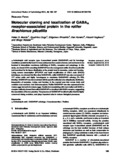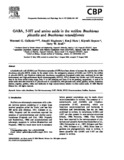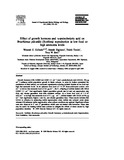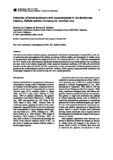Molecular cloning and localization of GABAA receptor-associated protein in the rotifer Brachionus plicatilis
Share
Abstract
γ-Aminobutyric acid receptor type A-associated protein (GABARAP) and its homologs constitute a protein family found in many eukaryotes from yeast to human, and are known to be involved in intracellular membrane trafficking of GABAA receptors and autophagy. In this study, we cloned cDNA-encoding GABARAP from the monogonont rotifer Brachionus plicatilis and examined for its tissue distribution at the protein level in neonates, males and females. Using reverse transcription (RT)-PCR and rapid amplification of cDNA ends (RACE) techniques, we showed that like other GABARAPs, rotifer GABARAP was also composed of 117 amino acids and highly homologous to vertebrate GABARAP2 ortholog (74–76% identity). GABARAP was demonstrated with its specific antibody to be ubiquitously distributed, irrespective of neonates, males, and females, in the coronal area that covers brain and contains most mechano- and chemoreceptors. Rotifer GABARAP was also expressed in the mature eggs but not in immature eggs. Double immunostaining with mammalian anti-GABA γ receptor antibody showed that rotifer GABARAP co-localized with GABA receptor, suggesting the association of the two proteins. The presence of GABARAP in rotifer implies that it is highly conserved during evolution, and plays important roles in various biological processes.
Suggested Citation
Marcial, H. S., Suga, K., Kinoshita, S., Kaneko, G., Hagiwara, A., & Watabe, S. (2014). Molecular cloning and localization of GABAA receptor-associated protein in the rotifer Brachionus plicatilis. International Review of Hydrobiology , 99(1-2), 188-197. https://doi.org/10.1002/iroh.201301720
Subject
chemoreceptors; antibodies; marine invertebrates; brain; receptors; proteins; transcription; hydrobiology; evolution; amino acids; eggs; reverse transcription; literature reviews; gamma-aminobutyric acid; phagocytosis; yeasts; membranes; acids; Brachionus plicatilis; Rotifera; young animals; gamma-aminobutyric acid
Collections
- AQD Journal Articles [1249]
Related items
Showing items related by title, author, creator and subject.
-
GABA, 5-HT and amino acids in the rotifers Brachionus plicatilis and Brachionus rotundiformis
Gallardo, Wenresti G.; Hagiwara, Atsushi; Hara, Kenji; Soyano, Kiyoshi; Snell, Terry W. (Elsevier, 2000)γ-Aminobutyric acid (GABA) and 5-hydroxytryptamine (5-HT) have been shown to increase the reproduction of the Brachionus plicatilis (NH3L strain). In the present study, the endogenous presence of GABA and 5-HT in the ... -
Effect of growth hormone and γ-aminobutyric acid on Brachionus plicatilis (Rotifera) reproduction at low food or high ammonia levels
Gallardo, Wenresti G.; Hagiwara, Atsushi; Tomita, Yuichi; Snell, Terry W. (Elsevier, 1999)Growth hormone (GH, 0.0025 and 0.025 I.U. ml−1) and γ-aminobutyric acid (GABA, 50 μg ml−1) enhance rotifer population growth in batch cultures. In order to further understand the mechanism of their ... -
Induction of larval settlement and metamorphosis in the donkey-ear abalone, Haliotis asinina Linnaeus, by chemical cues
Gapasin, Rolando S. J.; Polohan, Bernice B. (Springer Verlag, 2004)The effects of the chemical inducers, gamma-aminobutyric acid (GABA) and potassium chloride (KCl), on the larval settlement and metamorphosis of the donkey-ear abalone, Haliotis asinina, was investigated. H. asinina larvae ...




